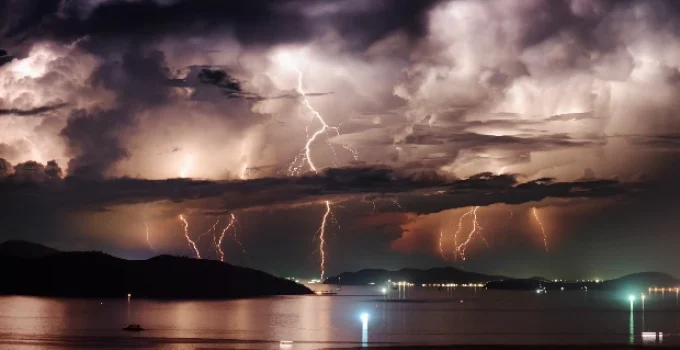How Do Thunderstorms Form?
Answer:
Thunderstorms form when warm, moist air rises, cools, and condenses into clouds, releasing energy that powers lightning, thunder, and heavy rain. This rising air creates a strong updraft, and if the conditions are unstable and moist enough, a thunderstorm can form. Most thunderstorms are short-lived, but some can grow into powerful supercells.
Dive Deeper
- The Three Ingredients of a Thunderstorm
- The Life Cycle of a Thunderstorm
- Where Thunderstorms Usually Happen
- Thunder, Lightning, and Rain
- 🎯 Final Thoughts
- 📚 References
The Three Ingredients of a Thunderstorm
Thunderstorms don’t just appear out of nowhere. They need three main ingredients:
| Ingredient | What It Does |
|---|---|
| Moisture | Comes from oceans, lakes, or humid ground and provides fuel for clouds |
| Instability | Occurs when warm air is near the ground and cool air is higher up—this causes rising |
| Lift | Something pushes the air upward, like a cold front or mountain |
🌡️ According to the National Weather Service, these three things—moisture, lift, and instability—must work together to create a thunderstorm.
The Life Cycle of a Thunderstorm
Thunderstorms usually go through three main stages:
1. Developing Stage
- Warm air rises quickly into the sky (updraft).
- Water vapor cools and condenses into cumulus clouds.
- No rain yet, just cloud growth.
2. Mature Stage
- The storm is fully developed.
- Heavy rain, thunder, lightning, and sometimes hail occur.
- Strong updrafts and downdrafts happen at the same time.
📊 This is the most dangerous stage. According to the NOAA National Severe Storms Laboratory, the mature stage can lasts an average of 10 to 20 minutes, but may last much longer in some storms.
3. Dissipating Stage
- The downdraft (falling cool air) cuts off the updraft.
- The storm weakens.
- Rain slows down and the cloud begins to shrink.
| Stage | Key Features |
|---|---|
| Cumulus | Cloud building, rising warm air |
| Mature | Lightning, rain, hail, strong winds |
| Dissipating | Downdrafts dominate, storm weakens |
Where Thunderstorms Usually Happen
Thunderstorms are most common in warm, humid places, especially during the summer months. The United States has more thunderstorms than almost any other country—especially in:
- Florida (nicknamed the “Lightning Capital”)
- The Great Plains (known as “Tornado Alley”)
- The southeastern U.S.
🌍 According to NASA Earth Observatory, the longest lightning bolt ever recorded was over Argentina and Brazil spanning 440 miles.
Thunder, Lightning, and Rain
A thunderstorm is not just about rain—it’s a combination of powerful natural forces:
- ⚡ Lightning: Caused by the build-up of electrical charges in the storm. When the difference becomes too strong, a bolt of electricity jumps between clouds or to the ground.
- 🌩️ Thunder: Happens when lightning heats the air around it to over 30,000°C (54,000°F)! This sudden heat causes the air to expand quickly, creating a shockwave we hear as thunder.
- 🌧️ Rain and hail: Water droplets collide, grow larger, and eventually fall. In stronger storms, these can freeze into hail.
🧪 According to Britannica, the sound of thunder reaches your ears after lightning flashes because sound travels slower than light.
🎯 Final Thoughts
So, how do thunderstorms form? Thunderstorms are exciting but powerful events in nature. They form when warm, moist, unstable air rises and cools, condensing into towering clouds. With enough moisture and lifting force, these clouds grow into storms full of lightning, thunder, and rain. While most thunderstorms are brief, they remind us how important weather science is—and why understanding the atmosphere helps us stay safe.
📚 References
💻National Weather Service. “How Thunderstorms Form.”
https://www.noaa.gov/jetstream/thunderstorms/ingredients-for-thunderstorm
💻UCAR Center for Science Education. “How Thunderstorms Form.”
https://scied.ucar.edu/learning-zone/storms/how-thunderstorms-form
💻NOAA National Severe Storms Laboratory. “Thunderstorms and Lightning: The Underrated Killers.” https://www.weather.gov/media/grr/brochures/nwsthunderstorms&lightning.pdf
💻NASA Earth Observatory. “A New Look at Earth’s Lightning.” https://earthobservatory.nasa.gov/images/149301/a-new-look-at-earths-lightning
💻NASA Earth Observatory. “Lightning and Thunderstorms.”
https://earthobservatory.nasa.gov/features/Lightning
💻UCAR Center for Science Education. “Thunder and Lightning.” https://scied.ucar.edu/learning-zone/storms/thunder-and-lightning
💻Britannica. “Thunderstorm.”
https://www.britannica.com/science/thunderstorm
📌Learn More About Atmospheric Phenomena
- How Do Supercell Thunderstorms Form? ⛈️
- Why Is It Hotter in Summer and Colder in Winter?
- Why Does It Snow Instead of Rain? ❄️
- Why Is the Sky Blue During the Day and Red at Sunset? 🌅
- What’s a Microclimate and Why Is It Important? 🌳
